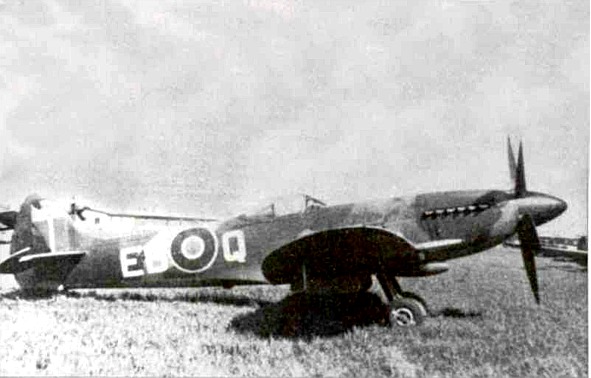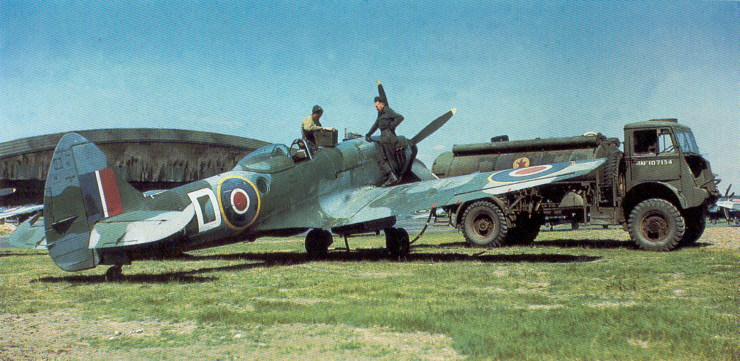Wing span: 36 ft., 10 in.
Length: 32 ft., 8 in.
Height: 12 ft., 7.75 in.
Weight: Max. Gross Load – 8,500 lbs.
Empty Weight: 6,376 lbs.
Max. Speed: 439 m.p.h. at 24,500 ft.
Ceiling: 43,000 ft.
Initial Climb: 4,580 ft. per min.
Climb: 20,000 ft./ 7 min.
Range: 620 miles at 271 m.p.h.
Engine: Rolls Royce Griffon 65 liquid-cooled V-12 with 2-speed, 2-stage supercharger/2,050 h.p.
Only 957 production Mk XIVs were built. It was the first Spitfire in large-scale production with the V-12 Rolls Royce Griffon 65 engine, and entered service in 1944. The Mk XIV was the most successful of all the variants at destroying V-1 flying bombs, accounting for 300 kills. In October 1944 a Mk XIV had the distinction of being the first to destroy a jet-powered Messerschmitt Me 262.
Our Spitfire was built at the Aldermaston factory in Berkshire, England and then delivered to the Royal Air Force. The aircraft was shipped to Karachi, India in July, 1945 for anticipated operations in Southeast Asia. In 1947 it was transferred to the Indian Air Force.
In 1983 the aircraft was found badly damaged in Patna and was returned to England. It was restored and flew again at Cranfield in 1983. The aircraft was painted in the colors of the South East Asia Command.
In 1985 the aircraft was purchased by David Price and shipped to Los Angeles. That year the aircraft won an award at the Oshkosh Air Show. Now owned by the CAF, this Spitfire Mk XIV is at the CAF, Southern California Wing’s Hangar at Camarillo Airport. It is currently in flying status and is available for airshow bookings year-round.
Spitfire NH749 Background
This essay is being written on the 14th of July 14, 2008 to provide a more detailed look into the whereabouts of this amazing aircraft. On this day, sixty two years ago, a Supermarine Spitfire FR Mk.XIV was on its way to the sub-continent of India. Today that same aircraft, serial number NH749, is sitting in our hangar here in Camarillo. How it got here and what has happened to it since then is an interesting story.
Built at the Supermarine factory at and assembled at the satellite plant at Aldermaston where it was test flown in late 1944. It was delivered to number 33 Maintenance Unit (MU) on 23rd Feb. 1945. From there it went to 215 MU on 20th May 1945. Having missed the war in Europe, she was sent on 2nd July 1945 to India on the S.S. Samaturdy arriving on the 28th. On the 9th of August she was assigned to the RAF’s South East Asia Command. Since this was the day that the second atom bomb was dropped and Japan surrendered five days later. It seems that the RAF never found it necessary to operate NH749. Instead she went into storage until being sold to the Indian Air Force on 29th Dec 1947. Her service in India remains largely a mystery although a tantalizing reference appears here http://www.bharat-rakshak.com/IAF/History/1950s/Wilson01.html
She was found by the Hayden-Bailey brothers languishing in there in 1978 and was brought back to England. http://www.bharat-rakshak.com/IAF/History/Aircraft/Spitfire/SpitNH749o.jpg
The fighter was restored to flying condition by Craig Charleston, sold to Keith Wickenden and appropriately registered G-MXIV. The next owner was David Price’s Museum of Flying in Santa Monica from 1985 until 2005 when he sold it to us.
Shortly after arriving at our facility, the aircraft was being flown by Steve Barber when it suffered a loss of coolant. Steve is a very experienced and skilled pilot and he was able to nurse the aircraft back to Camarillo for an uneventful landing. It was determined that the engine needed to be removed and sent out for overhaul. Mike Nixon’s excellent Vintage V-12’s facility in Tehachapi, California was selected for this work. Removing the engine was quite a task and this was overseen by Leslie Bedding who was a mechanic in the RAF during WW2 and had, coincidentally, served in India. Les is a very gifted craftsman and a stickler for detail and high standards. He determined that our Spit needed quite a bit of work. To achieve all this, he assembled a team of volunteers consisting of his son Colin, Dick Roberts, Robert
The entire coolant system has been refurbished, the engine mounts have been sent out for X-Ray testing as have the undercarriage components. All of the wing attach bolts as well as the undercarriage attach bolts have been replaced with newly manufactured ones. The canopy was found not to operate correctly so that’s being redone. The hydraulic, pneumatic and electrical systems have all been thoroughly tested by Les and components repaired or replaced as necessary. The colors used in the original restoration were not stock and so it was decided to restore the cockpit, engine compartment and as many other components as possible to their proper colors. Colin Bedding is leading this effort and it is far from easy! The aircraft is now being reassembled in preparation for the return from Vintage V-12’s of our engine. The installation of the engine represents an enormous undertaking. The cooling system and its associated plumbing is complex and the airframe in which they fit is very tight. There are many busted knuckles and frayed tempers on the horizon.
At the moment, the aircraft is finished in South East Asia markings. This is about to change as we are considering a European color scheme and the markings of 41 Squadron which flew low backed F Mk.XIV with the 2nd Tactical Air Force from former Luftwaffe bases in liberated Europe in 1945, scoring many victories over a wide range of German Air Force types including a number of jets. 41 Sqn. is one of the oldest still serving with the RAF today after 92 years of continuous service.
Each of the combatant nations involved in the Second World War seems to have produced an aircraft that has become an icon. For the U.S., it is the P-51. For the Germans, the Bf 109 and the Japanese have the Zero. For the British, that aircraft is the Spitfire. Even people with absolutely no interest in aviation can usually recognize the graceful form of the Supermarine Spitfire. The Southern California Wing is fortunate enough to count one of these fighters in our collection.
As most of you know, the Spitfire was designed in the mid thirties by R.J. Mitchell and the prototype, serial number K5054 was first flown by Supermarine chief test pilot Mutt Summers at 4:35p.m. on March 5th, 1936. The flight lasted 8 minutes with no problems and as he stepped down from the aircraft afterward, Mr. Summers’ terse instructions were “I don’t want anything touched!!” It was an auspicious beginning.
The Spitfire was accepted by the Air Ministry and although it’s designer died shortly after it’s first flight after a long illness, responsibility for it’s subsequent development was placed in the very capable hands of an unassuming man with an unassuming name; Joe Smith. Throughout its entire development period from 1935 to 1948 there were no significant failures of the basic design. Mutt Summers moved on to become the chief test pilot for Vickers and most of the production and developmental test flying was accomplished by Jeffrey Quill and Alex Henshaw, ably assisted by others too numerous to mention here. Smith, Quill and Henshaw oversaw improvements in the capabilities of the Spitfire which can only be described as remarkable.
To give some idea of the engineering genius of this team, please consider the following comparisons between the Mk IIa which achieved immortality during the Battle of Britain in 1940 and our FR. Mk.XIVe which first saw action in 1944:
Gross weight went from 6000lbs to 8400lbs. The FR Mk.XIV used a Rolls Royce Griffon 65 of 2050HP http://en.wikipedia.org/wiki/Rolls_Royce_Griffon and http://www.spitfireperformance.com/griffon-65.pdf versus the Mk.II’s Merlin XII of only 1175HP http://en.wikipedia.org/wiki/Rolls_Royce_Merlin Maximum speed of the Mk.II was around 355mph at 19000ft while the Mk.XIV achieved 448mph. Handling was similarly improved with roll rates at high speed providing the most dramatic evidence of this: at 400mph a pilot could roll the Mk.XIV 60deg. in 1.2 seconds whereas the Mk.II took almost 5 seconds. Range also went up, almost doubling to 860 miles. These huge improvements were achieved with very few changes to the basic layout or dimensions of the original design.
Mk XIV Spitfires came in two flavors; F for fighter and FR for Fighter Reconnaissance. These can be distinguished by the fact that the FR version has a camera port on each side just aft of the cockpit canopy which the F version lacks. The Mk.XIV also has two fuselage versions known as either a “High Back” or a “Low Back”. The “High Back” has the normal, classic Spitfire three piece canopy that we are all familiar with whereas the “Low Back” has lower turtle deck and a bubble canopy similar to a P-51. F Mk.XIV’s could be either high or low back versions whereas FR Mk.XIV’s are always low back.


